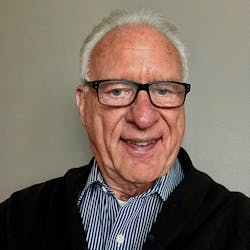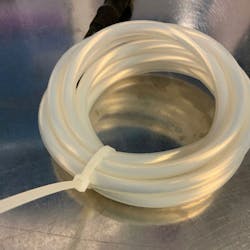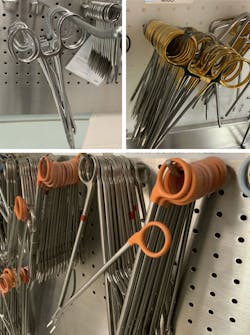For safety, effectiveness, SPD’s endgame must be cut and dried
To aerate, dry and store or not to aerate, dry and store, there is no question.
Endoscopes and other medical/surgical devices and instruments with lumens, niches, nooks and secluded recesses may be used to repair patients and steer them on the road to healing and recovery but they also potentially cause harm when they’re not completely cleaned, high-level disinfected or sterilized, aerated and dried in sterile storage.
In fact, even if all organic material and residue from a procedure were removed successfully via reprocessing, but elements of moisture remained, the dangerous risk of contamination and infection to the next patient lingers. That’s what sterile processing and distribution (SPD) professionals know that makes aeration, drying and storage such important components of the reprocessing procedure – and they must be managed properly to prevent shortcuts during time crunches and turnover demands. After all, in many cases, shortcuts can lead to shortfalls, experts agree.
All told, problems in the aeration, drying and storage process, while an integral part of sterile processing at the end, may not only involve the process itself but other mitigating factors.
Staffing and supply
“Another challenge has to do with staffing,” Ostrander continued. “Whether it’s high turnover rates or inadequate staffing that you’re facing, ensuring that staff are knowledgeable of the proper procedures to reprocess items that may harbor moisture can be tricky if you don’t have enough staff to help and you don’t take the time to help properly train incoming new hires.”
“Historically it was subjective, like early definitions for ‘clean,’” Radford told Healthcare Purchasing News. “Fortunately, this clean endpoint has evolved to a more precise description from merely visual inspection to grams per square centimeter of debris. ‘Dry’ is moving on from estimating or observing dryness (subjective) to a more scientific condition of ‘clinically dry’ that has been established through a rigorous process with solid documentation.”
Radford refers to a disciplined study performed in a clinical setting that demonstrated a way to determine drying times for specific instruments (in this case, robotic devices) to assure a clinically dry state. “Robotic surgical devices contain small lumens, complex chambers and tortuous pathways in which water can accumulate and must be removed to prepare for subsequent steps in the reprocessing cycle,” he said. “The study [found via Cenorin’s website] describes a precise, controlled methodology that helps provide greater assurance than a subjective judgment.”
But Radford cautions that the presence of moisture is not the only barrier to clinical dryness.
“Each medical device brings its own challenges,” he noted. “Device design and material aspects, such as interior and exterior surface shapes and textures, device component materials, and the shape, size and configuration of ports, can all become challenges to successful drying. Robotics, endoscopes, CPAP circuits, sequential compression devices, nebulizers, LMAs and hundreds of other semi critical devices each present their individual challenges.”
Radford recommends looking at the materials used to process devices, too.
“Many devices are processed using liquids or other chemicals that may leave a residue that penetrates the surface material of a device and may require aeration,” he observed. “Modern drying systems aid in the aeration process using controlled heat and exhaust air. When aeration and drying are complete, some drying chambers can also be part of a staging or storage plan. To be used in this way, the chamber must be sealed to prevent external contamination or protected with HEPA filtered circulating or continuous heated or room temperature air.”
Radford acknowledges that each type of lumened or complex device presents its own challenges for drying and storage, so he advises a key step to initiate any changes in the process.
“We suggest performing an inventory of the devices used in your hospital and determining what specific drying conditions are most effective for each one,” Radford said. “It might also be helpful to compare the various available drying systems and cabinets to determine which ones have the features that meet your needs best. Consult each drying chamber manufacturer to determine whether they have engineered their drying process to handle all of your devices, and whether they can share validated data to demonstrate drying effectiveness.
“In a quality-focused healthcare environment, the critical contribution of effective drying is becoming an even more important factor in the reprocessing cycle because of its contribution to the next safe use of each device,” he added.
“While challenges occur in all facets of the process, the storage of extra instruments and devices is an important concept that is often overlooked but can have a negative impact on patient outcomes when done incorrectly,” Elammari noted. “The use of organizational items such as peg boards and bins are beneficial for helping with space constraints and easy instrument identification; however, they are not a set it and forget it concept. These items must be maintained and not serve as collection points for dust which act as fomites for microbes. If these items make it to the patient they can lead to complications for the patient.”
“Endoscope sterile reprocessing departments are often fast-paced environments that require quick turnover of reprocessed scopes to meet the demands of a high caseload facility,” he said. “Reprocessing technicians need to feel confident that a stored endoscope has been through a drying cycle. Forcing air through the internal channels of the endoscope to promote drying helps remove moisture that might not drain out by simply hanging the scope vertically in a cabinet. Removing this internal moisture with forced air can mitigate bacterial growth and contamination in a reprocessed endoscope.”
Picking a pathway
Quantity should not surpass quality such that shortcuts lead to slipups with dire consequences, according to Theresa Kunsman, Senior Product Manager, Cleaning/Disinfection/Sterilization, Olympus Corporation of the Americas.
“Controlling the human factor in reprocessing is always a challenge,” Kunsman indicated. “The key to effective reprocessing is repeated and consistent execution of the device’s defined process each time the endoscope is cleaned. On busy days, some technicians may be inclined to ‘speed up’ a process. It is important to stress the quality of cleaning and put processes in place to keep external pressures from influencing technicians to hasten the cleaning or sterilization process.”
Kunsman advises that SPD implement drying processes that should be dependent on whether the device is sterilized or disinfected before storage.
“This is because drying occurs before an endoscope is sterilized but occurs after an endoscope is disinfected,” she noted. “Separate drying devices should be designated for sterilization and disinfection to avoid contamination of high-level disinfected scopes.
“Simply managing two distinct drying processes in the same department can be challenging,” Kunsman recognized. “A workaround for this issue that is sometimes adopted is high-level disinfecting of the endoscope before drying and sterilization. This allows the same drying device to be used without the fear of contamination. In this scenario, the time for sterilization is increased by the length of the HLD process. Technicians must be educated on both sterilization and disinfection processes – unless the facility is able to designate experts for each area.”
Kunsman advises that technicians need to be able to identify the proper category each device requires – whether high-level disinfection or sterilization.
“The ultimate challenge is selecting the process that works best in the facility and evaluating the cost/benefit of maintaining separate drying devices against adding additional time for sterilization,” she said. “In the case of sterilization, ensuring the device is completely dried is critical because moisture can impede most sterilization processes. For example, if moisture is present during steam sterilization, the sterilizer may experience condensation issues. Some sterilization units have a built-in abort mechanism if moisture is detected. Drying before sterilization may include the use of a clean lint-free cloth to wipe external visible moisture, pressure-controlled compressed air, and a drying device/cabinet.
“The drying process is also critical for high-level disinfected devices because any residual moisture left after disinfection can promote bacteria growth,” Kunsman continued. “Drying a device after disinfection may include wiping the external surface of the device with a clean, lint-free cloth, and drying with highly filtered air, such as instrument air. Using a drying cabinet to complete the drying process provides a controlled environment for drying, limits exposure to external contaminates and helps protect the endoscope from damage.”
SPD should evaluate this process beyond the confines of its departmental footprint as well, according to Kunsman.
“Most SPDs do not store devices in that department,” she said. “In many cases, the devices are transported to a separate department. SPDs must develop a method of transport and storage that maintains the endoscope reprocessing status and protects the device from damage. Tracking methods must also be included in the overall process. This enables device location, validation of reprocessing status, and process management.”
Inside the lines
While some areas to watch to ensure proper aeration and drying works may be overt, others are more covert and hard to find – and cannot be dismissed, ignored or missed, experts argue.
“Surgical instruments can be very complex these days, and staff may not be aware of areas that may hold moisture or what needs to be disassembled for proper drying,” said 3M Health Care’s Ostrander. “When acquiring new instrumentation, it is important to educate staff through in-services on proper cleaning and assembly methods to help ensure instruments aerate and dry properly.”
Ostrander lists several examples of areas that may hold moisture or need to be disassembled for proper drying, such as depth gauges, suctions and certain laparoscopic instruments like graspers.
The internal complexities and differences between endoscopes must be understood to ensure proper drying of the internal channels, according to Solaire’s Champion. “Not all channels are interconnected within some endoscope models, meaning that directing air through one port does not necessarily mean all residual moisture is being removed from the endoscope,” he indicated. “The length of the endoscope and size of the lumens may contribute to the amount of residual moisture left in the endoscope after the AER cycle. Failure to leave the endoscope in a drying cabinet for a sufficient length of time may result in an incomplete drying cycle, thus allowing for residual moisture to promote bacterial growth. Additionally, environmental factors like water quality, ambient temperature and humidity and atmospheric pressure can have an impact on the effectiveness of a drying cycle within an endoscope drying cabinet.
“Each facility should perform a risk assessment to verify that a standard drying cycle is sufficient to remove moisture and minimize the potential for contamination in endoscopes,” Champion added.
“The manner in which extra instruments are stored can be damaging to the instrument and in turn does not allow for proper functionality during surgical procedures,” she noted. “For example, when placing ringed instruments on a peg board, some facilities clamp the ratcheted instruments closed in an effort to utilize one peg and save space. This practice places stress on the box lock of the instrument and with time can diminish its ability to function correctly. An additional example would be with light cords. According to most light cords’ IFUs they should be stored coiled no less than six or eight inches. Coiling less than this will cause the light fibers in the cord to break and reduce the amount of light produced. This translates to a dark operating view for the surgeon.”
Olympus’ Kunsman stresses the innate importance of aeration, drying and storage of surgical devices for the durability and lifecycle of the devices.
“Even with the proper drying methods and devices, whether sterilizing or high-level disinfecting, verifying dryness can be a challenge,” she said. “This is because there are no broadly available methods for determining if a device is dry. Ensuring proper care and handling of equipment during reprocessing and transport should be managed because this can directly impact drying effectiveness and device longevity. Finally, checks and balances should be implemented to ensure proper reprocessing and drying steps are performed.”
References
1. Association of periOperative Registered Nurses. Guideline for Processing Flexible Endoscopes. Revised February 2016 for publication in Guidelines for Perioperative Practice, 2016 edition
2. “ANSI/AAMI ST91:2021: Flexible and Semi-rigid Endoscope Processing in Health Care Facilities.” Association for the Advancement of Medical Instrumentation. Published March 1, 2022
3. Society of Gastroenterology Nurses and Associates. Standard of Infection Prevention in the Gastroenterology Setting. 2016.
4. Multisociety Task Force Article. Guideline on reprocessing flexible GI endoscopes and accessories. 2021.
Tips, tools, tricks for device aeration, drying and storage
Maintaining standard, traditional and minimally invasive surgical devices – particularly during peak demand or elective and scheduled procedural demand spikes – can escalate to pressure cooker situations for sterile processing and distribution (SPD) professionals.
SPD experts share some relevant and useful recommendations to help relieve some of the pressure once the devices exit the high-level disinfector or sterilizer. Note that some overlap or may be repetitive for emphasis.
- Make sure to consult your endoscope’s Instructions for Use (IFU) for proper aeration and drying methods (such as blowing air and/or using alcohol) as well information on the proper way to store the scope. There is no one-size-fits-all way of cleaning that applies to all endoscopes, so it is important to know what specific steps need to be taken to ensure proper cleaning and storage for your scopes.
- Scopes also should be hung and stored as soon as possible after cleaning is finished to allow for adequate drying. Documentation that contains the date of reprocessing and initials of who cleaned it is important to help identify scopes that have reached your facility’s identified storage time.
- Make sure your endoscope storage cabinets are clean. Storage cabinets should be cleaned according to the manufacturer’s IFU. However, doing visual inspections of the cabinet whenever storing or retrieving endoscopes can help ensure the cabinet’s cleanliness is maintained between scheduled cleaning times.
Kayla Ostrander, Application Engineer, Device Reprocessing, 3M Health Care Business Group, Medical Solutions Division
The below useful tips stem from some of the main issues that I have seen at different facilities.
- The cloth that is being used to dry the outside of the scope should be changed with each scope.
- Scopes that come out of the [automated endoscope reprocessor] should be tagged as clean and with additional information per AAMI ST91
- Handheld air guns do not allow for proper drying of scopes internal lumens; invest in an automated system or drying cabinet.
- Ensure your leak tester’s pressure is being tested each day it is in use. This is different from pushing the pin prior to processing a scope. This involves testing the actual unit and cord.
- Transportation of dirty scopes should be in a biohazard-marked containment device that has an IFU for proper care and handling.
Malinda Elammari, CST, CSPM, CSPDT, CFER, CSIS, CRCST, CIS, CHL,CER, CLSSGB, Clinical Education Specialist, Healthmark Industries Co.
- The drying cycle in an AER is a purge, not a validated drying cycle.
- Both the exterior of the scope and accessible channels need to be actively dried.
- Low-linting wipes need to be used for external drying.
- Instrument air or HEPA-filtered air needs to be used for channel drying.
- Based on research to date, channel drying should occur for at least 10 minutes.
- Holding an air gun to the proximal working channel does not ensure drying of the entire channel.
- Scopes need to be dried before storage in a conventional vertical storage cabinet or they need to be placed in a dedicated channel drying cabinet.
- Conventional storage cabinets need to have active filtered air circulating through the cabinet.
- Embedded QC for active drying would include the use of periodic drying verification testing.
John Whelan, Clinical Education Specialist, Healthmark Industries
- • Endoscope channels be dried for a minimum of 10 minutes with pressure-regulated forced instrument air (or, at minimum, HEPA-filtered air). If moisture is still observed, the drying time should be extended until no moisture is visible. The endoscope manufacturer’s written IFU should be reviewed for the maximum PSI. Note: Manual drying should occur even if an AER is used, and it has an air purge or extended dry time feature.
- They also looked at the use of alcohol and came up with the following recommendation:
- • The use of alcohol has long been recommended in the drying process after disinfection is completed; however, some studies have shown that alcohol can be a fixative agent. For that reason, ST91 now recommends that a multidisciplinary team (with representation from infection preventionists, endoscopy and perioperative nurses, endoscope processing personnel, endoscopists, and other involved personnel) conduct a risk assessment to determine whether endoscope lumens should be flushed with 70% to 90% ethyl or isopropyl alcohol. Since no two facilities are alike, the use of a risk assessment makes perfect sense.
Sharon Ward-Fore, BS, MS, MT(ASCP), CIC, FAPIC, Infection Prevention Advisor, Envista
- Using a drying cabinet that directly connects to the endoscope lumens and forces air through the internal channels is preferred over simply hanging in a cabinet.
- Facilities should conduct a risk assessment to determine the appropriate length of drying cycle and appropriate maximum storage time for their endoscopes.
- Place the endoscope into a drying cabinet and initiate the drying cycle as soon as possible after the endoscope is removed from the AER.
- Conduct periodic inspections of the internal channels of endoscopes to ensure moisture is completely removed through a standard drying cycle.
- Follow manufacturer IFUs for endoscopes, reprocessing equipment and drying cabinets.
Aaron Champion, Vice President, Endoscopy Sales, Solaire Medical
- Ensure endoscope manufacturer instructions for use (IFUs) are followed for maximum psi allowed for endoscope channels.
- If possible, dry in a controlled environment such as a drying cabinet with instrument air or a minimum of HEPA-filtered air. This helps limit exposure of the clean endoscope to airborne contaminates.
- Designate a defined drying space in your reprocessing/sterilization flow. Ensure the drying space does not cross over into the dirty space. Keep the reprocessing flow unidirectional.
- To protect the integrity of the endoscope, vertical hanging is best for long-term storage. The use of a drying cabinet for storage is preferred. If a drying cabinet is not available, endoscopes may be completely dried, and then stored in a standard cabinet with HEPA filtration, ventilation and air flow.
- Follow drying cabinet or drying device manufacturer instructions for use (IFUs) for filter changes. This is critical to ensure the quality of air that is exposed to clean endoscopes.
Theresa Kunsman, Senior Product Manager, Cleaning/Disinfection/Sterilization, Olympus Corporation of the Americas
- The quality of compressed air used to dry endoscopes is important. Inadequately filtered air could introduce contaminants to a clean endoscope. Societies are moving toward the use of instrument-quality air. The AORN guidelines state, “The exterior surfaces of the endoscope should be dried with a soft, lint-free cloth or sponge and all channels purged with instrument air.” AAMI has also noted that endoscopes that have completed an HLD cycle should undergo additional drying internally with instrument air. SGNA indicates that step #8 in endoscope reprocessing is drying, “which requires an alcohol flush, followed by forced-air drying with instrument-quality compressed air.”
- Heath care facilities should avoid the use of oil-based compressors for drying endoscopes.
- When drying endoscope channels, be sure the maximum air pressure introduced does not exceed manufacturer IFU requirements. The latest Multisociety Guidelines recommend, “Endoscopes should be completely dried after reprocessing and before use.” AAMI ST91 2021 guidelines have taken this a step further and recommend that endoscopes with channels should be dried for a minimum of 10 minutes with pressure-regulated forced instrument air or a minimum of HEPA-filtered air. If moisture is still observed after 10 minutes, drying time should be extended until no moisture is visible.2
- Whenever possible, store the endoscope in a drying cabinet. If a drying cabinet is not available, dry the endoscope (exterior and lumens) and hang it in a well-ventilated HEPA cabinet that provides positive pressure.
- Once disinfected, endoscopes should be dried and stored in a way that will protect them from external contaminants. Hang the endoscope in a vertical position to enable drying and maintain scope integrity. Remove caps, valves, and other detachable parts per IFU instructions.
Melinda Benedict, Director, Infection Prevention and Control, Olympus Corporation of the Americas
About the Author
Rick Dana Barlow
Senior Editor
Rick Dana Barlow is Senior Editor for Healthcare Purchasing News, an Endeavor Business Media publication. He can be reached at [email protected].










